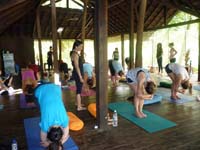Wild dogs, cyclones, and lots and lots of chai!
Written by Ana Davis
I’m not a natural traveler; it doesn’t come easily to me. After 6 months of frequent overseas trips, I felt almost unwillingly pulled along by the bus that took us to Brisbane airport, preparing to set off across the oceans to India, far away, yet again, (sigh) from my little boy, and my home.
However, these feelings of reluctance lifted the moment we were in the taxi from Goa airport, tearing through the South Indian countryside, the warm wind in my hair, Bollywood music blaring, dodging cows and heavily loaded mopeds. Ahhh… Indiahhh…already weaving her magic.
Still, it’s not all chai and mogra-blossoms. India, even gentle Goa, has its challenges. What with the voracious mosquitos feasting on our fresh, foreign blood whilst we practiced and (attempted to) meditate; the all-too frequent power failures; the howling of wild dogs keeping us awake at night; add to that, some unforeseen issues with the flimsy bamboo, beach huts, in which some of our group were almost blown away into the Arabian sea, in a freak cyclone that struck India’s East coast.
In our welcome-session in the open air shala at Ashiyana, the picturesque yoga retreat centre, at Goa’s Mandrem beach, John encouraged us to consider the niyama, ‘tapas’, as a way of helping us deal with some of these perplexing frustrations and contradictions that India is want to offer up to its visitors. “Even though there are challenges and frustrations being in India, we need to look beneath the surface, beneath the dirt, to see that this is the home of yoga,” urged John. He explained that this pushing beyond our comfort zone, by just being in India, takes an engagement of the quality of ‘tapas’, sometimes described as ‘burning zeal or effort’. “It is this burning fire of tapas that cleanses our impurities,” he said.
This seemed to then set the theme for the remainder of our time there: an awareness of the rewards that come from surrendering, yet also working into unchartered territories, not only in the geographical sense, but also in our physical, Asana practice, and ultimately, in our own inner-lives, and how we interact with our world.

In essence, this is what is sometimes called ‘the edge’ in yoga. Waiting at Goa airport, Mumbai-bound, at the end of the India event, I talk to Judy about what she thinks it means to work or ‘play’ your edge in yoga practice.
“The edge is a very fine balance between backing off before you’ve already allowed yourself to get into the maximum of whether you can hold your power in a stretch and the sense of panic that may come about and cause you to back out,” muses Judy. She says that if you can just breathe and be in the pose/stretch, you might just find a new edge.
According to Judy there are three things that come up as potential obstacles for students when they are working in an Asana. The first is the ‘threshold of pain’, the second is the perceived lack of power or strength to be able to hold the pose, the third is the ego.
She goes on to explain: “The edge is the very fine line between backing off before you‘ve actually reached your potential, or, a lot of people may dive and push that little bit over their edge and that turns into abuse. It’s that fine interplay between the two.”
Of course, everything we do and learn on the mat, has a broader significance in our daily lives. If we can learn to play that fine balance, delicately perched neither too far in, or back, from our own, personal edge in our Asana practice, we can take this same fine-tuned awareness to benefit us in our real-world context.
With over 30 years of yoga practice and teaching behind her, Judy now has the wisdom to observe how she approaches her yoga practice, what her ongoing pattern is, as a direct reflection of what she has been able to do in her life. When she reflects on her own early years in yoga, she says she did what was expected of her by others, and she constantly pushed herself beyond the edge. The result was regular and chronic injuries. “The last time I landed up crawling to the front door on my hands and knees, because I’d injured my back. So I said, ‘that’s it!’ I realized it’s time go back to the drawing board. I went back to the absolute basics,” Judy says.
Judy started to realize just how organically the ‘lessons’ flowed and interfaced between her time on the mat and her daily life. “When I changed my attitude, I started to learn that when I approach my mat in the morning, if I found I was tired, I was not going to push myself for the rest of the day,” she says. “It made me say ‘no’ to things that would make me overdo”.
As Judy and I chat, I flick open a book she has lent me by Peggy Hackney – “Making Connections – Total Body Integration Through Bartenieff Fundamentals”, and the page falls open to this quote:
“ The ability to create relationships begins “at home”, within our own bodies and in the process of our development. But let’s look at relationship in a larger context as well, because everything we learn (in the book) about relationships within our bodies can also be applied to relationships in our larger world. And what we know about relationships with other people can be applied to relationships, within our own bodies.”
I ask Judy how her sensitivity of her own edge and its interplay between yoga and life, helped her during this experience – her time in India? Judy immediately recalls the night and day of the storm we had in Goa, in which there was a long power cut-out, including no water, not even to flush the toilet, as being particularly challenging for her.
She tells how she woke up in the dead of the wild night, in total blackness and she found her mind started to get carried away with its “own little story”. “ I thought: ’What happens if I’m blind?’”, she says. After feeling her way to the bathroom, Judy says she “found shelter” in her bed. “ My bed became my mat. My bed took on only where I was lying. Instead of being with the outer picture – the storm raging – I brought my awareness back to the inside of the room. But even that wasn’t comfort as it was pitch black. So then I took it into the bed, to just the space on my bed. Once I found where I was on my bed, I went back to my breathing,” she says.
Ultimately the breath is at the core of it. “When people tend to fall into the resistance; come up against what becomes for them a barrier, instead of always falling into the resistance of the barrier, they can then work with breath,” suggests Judy. She goes on to say that the breath has movement, and helps us to “find pathways beyond that resistance”. A powerful lesson that we probably all received, on some level, after our little India adventure.
